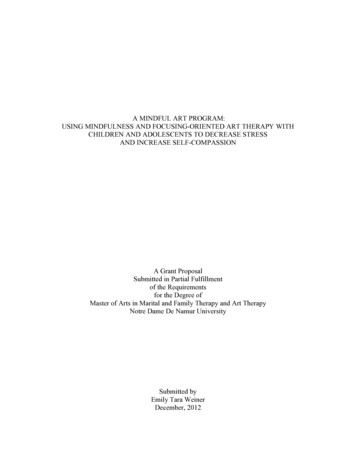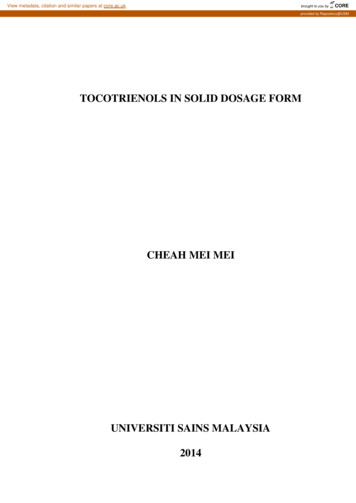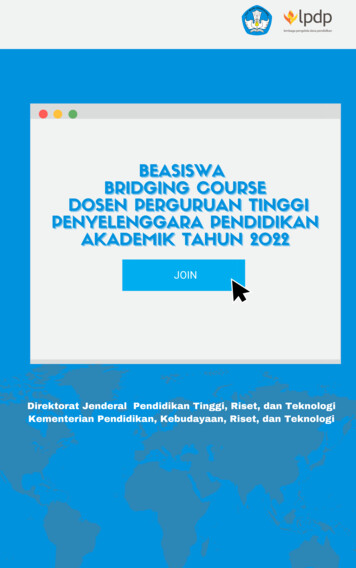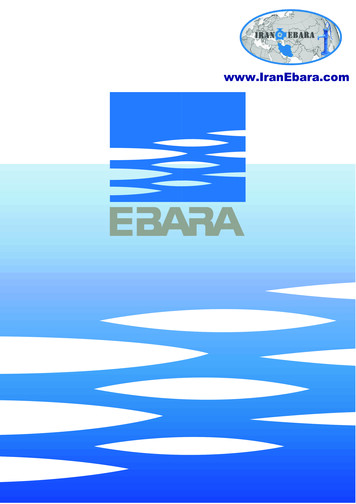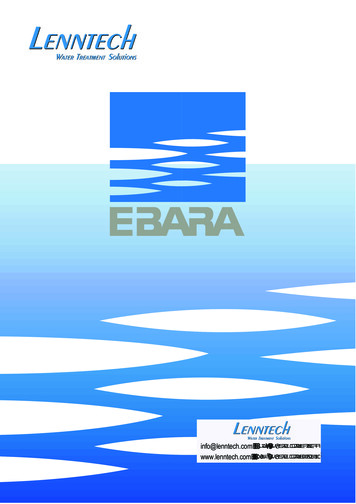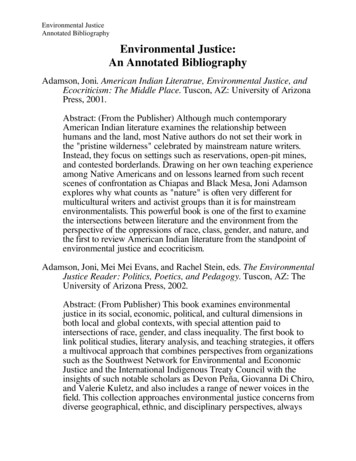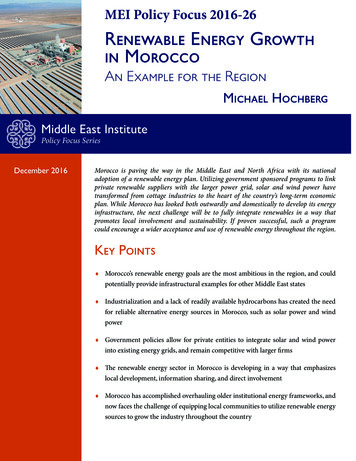
Transcription
MEI Policy Focus 2016-26Renewable Energy Growthin MoroccoAn Example for the RegionMichael HochbergMiddle East InstitutePolicy Focus SeriesDecember 2016Morocco is paving the way in the Middle East and North Africa with its nationaladoption of a renewable energy plan. Utilizing government sponsored programs to linkprivate renewable suppliers with the larger power grid, solar and wind power havetransformed from cottage industries to the heart of the country’s long-term economicplan. While Morocco has looked both outwardly and domestically to develop its energyinfrastructure, the next challenge will be to fully integrate renewables in a way thatpromotes local involvement and sustainability. If proven successful, such a programcould encourage a wider acceptance and use of renewable energy throughout the region.Key Points Morocco’s renewable energy goals are the most ambitious in the region, and couldpotentially provide infrastructural examples for other Middle East states Industrialization and a lack of readily available hydrocarbons has created the needfor reliable alternative energy sources in Morocco, such as solar power and windpower Government policies allow for private entities to integrate solar and wind powerinto existing energy grids, and remain competitive with larger firms The renewable energy sector in Morocco is developing in a way that emphasizeslocal development, information sharing, and direct involvement Morocco has accomplished overhauling older institutional energy frameworks, andnow faces the challenge of equipping local communities to utilize renewable energysources to grow the industry throughout the country
Michael HochbergIntroductionMorocco is poised to lead the MiddleEast and North Africa (MENA) region in renewable energy. Its lack of conventional hydrocarbon resources, highenergy import bill and rapidly rising electricity demand have provided Moroccowith the impetus to encourage renewableenergy development and emerge as a stabledestination for power sector investment.Morocco is not the only MENA countryto drive renewable energy developmentin response to strong electricity demandgrowth, expensive fuel imports and vulnerability of fuel supply. Jordan, for example,faces similar challenges, and has launchedits own renewable energy initiatives. In relative terms, however, Morocco has the mostambitious renewable energy targets in theMENA region, pledging to increase renewable energy capacity to 42 percent of totalinstalled capacity by 2020, and 52 percentby 2030.1 If successful, the Moroccan modelmay prove valuable for neighboring countries experiencing similar challenges.Demand GrowthMorocco’s ambitious targets reflect the nation’s rising energy demand, with electricity demand projected to increase by 250percent from 2015 to 2030, and primaryenergy demand forecasted to double in thesame period.2 Demand has been driven byeconomic growth, an increasingly wealthier Moroccan population and the nation’sindustrial sector, which includes electric-Michael Hochberg is amanagement consultantin the Global Energy& Utilities practice ofPA Consulting Group,where he providesregulatory, investmentand business strategysupport to power sectorclients including utilitiesand independent powerproducers. Prior to consulting, Michael worked at the Delaware Departmentof Natural Resources and Environmental Control,where he assisted with the implementation of publicpolicies, reporting to the state’s Secretary of Energy.Michael earned a B.A. summa cum laude from TulaneUniversity, and was awarded a Fulbright Scholarshipin 2012.ity intensive activities like mining and carmanufacturing.Increased electricity access has also contributed to rising demand. In 1990, less thanhalf of Morocco’s population had modernelectric services, yet a 1995 rural electricityprogram extended electricity access to tensof millions of people, with 98 percent of thepopulation covered by 2014.3 Accordingly,electricity demand has grown at an averageyearly pace of 7 percent since 2002, withresidential and industrial residential classes growing fastest, at 8 and 7.4 percent peryear, respectively.4 Together, these two customer classes make up more than 75 percent of electricity consumption.Demand growth has helped lead to an increasingly large energy import bill, whichcost Morocco approximately 8 to 10 billion annually from 2011 to 2013.5 Crude oiland petroleum products have historicallyRenewable Energy Growth in Morocco1
Figure 1: MENA Electric Generation Installed Capacity and Renewable Energy TargetsSources: CIA, IEA, Regional Center for Renewable Energy and Efficiency, National Ministries of Energymade up the majority of the country’s import bill, with coal, natural gas and electricity imports contributing to a lesser extent.Renewable EnergyRegulatory FrameworkTo manage demand growth, Morocco’s contemporary renewable energy plans beganto take form in 2009, through renewableenergy law 13-09. The law develops the legal framework for renewable energy development, and partially opens the electricitymarket to competition for the productionand commercialization of power from renewable sources.The law allows private entities to developrenewable electricity generation projects,and sell power to directly to large consumers, while providing guaranteed access to2Hochbergthe power grid in order to transport electricity. It also permits renewable energygenerators to develop transmission linesif existing transmission capacity is insufficient, and established a framework forthese generators to export electricity (Morocco’s grid has international connectionswith both Spain and Algeria).8 As a resultof this regulatory structure, Morocco experienced an addition of 2,760 MW of windand solar capacity between 2009 and 2015,9increasing the share of wind and solar installed capacity from two percent to morethan 12 percent.10Since the original law, legislation has developed further to include a net meteringscheme for solar photovoltaics (PV) andonshore wind generation, in which privategenerators connected to the high voltagenetwork can sell up to 20 percent of generation back to the grid.11
Figure 2: Electricity Consumption by Customer tial33%Source: IEAMorocco’s renewable energy industry,however, is in the early stages of development. To comply with targets, an additional10,100 MW of renewable energy capacitymust be developed by 2030, with 4,560 MWplanned for solar, 4,200 MW for wind, and1,130 MW for hydro.12 To fund projects, 30 billion of investment will be required,according to the Moroccan Ministry of Energy, Mines, Water and Environment.13Competitive TendersMorocco awards contracts for electric generation projects through competitive reverse auctions, in which independent powerproducers (IPPs) bid a price at which theywill produce each megawatt hour (MWh)of electricity, with the lowest prices favoredto win the auction. Used globally, competitive tenders provide a familiar frameworkfor international project developers. In thecase of wind, power purchase agreements(PPAs) that result from auctions are signedbetween the IPPs and ONEE (Morocco’sstate-owned electric utility and market operator). In the case of solar, PPAs are signedbetween the IPP and MASEN (MoroccanAgency for Solar Energy); MASEN thensigns a second contract to sell its purchasedpower to ONEE.14 To date, PPAs for durations have been between 20 and 30 years;long-term contracts for renewable generation output provide investor confidenceand facilitate financing.Access to financing has helped contribute tothe competitiveness of the auctions, whichhave produced winning bid prices as lowas 25/MWh for solar PV and 28/MWHfor wind. The prices set record lows globally for competitive renewable generationtenders. While this will help lower the costof electricity in Morocco and represents aRenewable Energy Growth in Morocco3
Figure 3: Morocco's Energy Import Spend100Morccan Dirham (MAD), 7Crude oil and petroleum products2008Coal200920102011Natural gasElectricity20122013November 2016 exchange rate: 1 USD 10.03 MADSources: Moroccan Ministry of Energy, Mines, Water and Environment – Energy Statistics 2014 , Energy Sector Key Figures ; Exchange rateby Xe.commajor win for the government and energyconsumers, it reduces the potential returnon investment.MASEN intends to hold two additional solar tenders in the beginning of 2017, with acombined capacity of 800 MW. German development bank KfW will provide approximately 765 million of financing, and additional lenders including the World Bankand the African Development Bank havealso agreed to participate.15Renewable EnergyDevelopmentFor solar projects, MASEN is not only theofftaker of electricity, but also becomes aminority equity partner for solar projects,and provides debt financing for the IPPs4Hochbergthrough multilateral agency funds borrowed by the Moroccan government. Thisarrangement increases the likelihood thatprojects are built, as securing post-tender financing is often a constraint for project developers. MASEN’s many varied roles alsohelps safeguard the interests of Morocco, byensuring deep Moroccan involvement andknowledge transfer in the development ofsolar projects. 16Morocco’s Solar Plan establishes a targetto develop 2,000 MW of solar capacity by2020, which will be comprised of both solarphotovoltaics and concentrated solar power (CSP).17 Unlike solar photovoltaics (PV),which use solar cells to directly convertsunlight to electricity, the CSP technologyin Morocco’s case will focus sunlight to heatfluid that is used to propel turbines, whichgenerate electricity.18
While CSP solar is more capital intensivethan solar PV, its generated electricity canbe stored and utilized in the absence of sun.Concessional financing offered by development banks - which can include preferredinterests rates and grace periods - helpsfund projects with higher capital costs, including CSP.19 More importantly, electricitystorage represents significant benefits forboth investors and Morocco’s power system.Storing electricity to be dispatched aftersundown increases the capacity factor (thepercentage of total capacity that is utilized)for the system, as solar PV systems cannotbe dispatched without sunlight. Higher capacity factors permit more electricity to besold, allowing investors to recoup additional dollars for MWhs sold in the evening.The storage capacity offered by the CSPplants also helps meet peak demand in theevening hours when people return fromwork; in Morocco, daily peak demand isFigure 4: global Horizontal IrradiationSource: solargis8:00 – 10:00 PM.20 Balancing solar supplywith peak demand through storage willhelp Morocco avoid the curtailment of intermittent energy resources (intermittentenergy sources may be curtailed by the system operator to avoid the risk of overgeneration).Figure 5: Installed Capacity 2015 vs. Projected Installed Capacity 202040%33% %0%SolarWindHydro2015Fuel OilCoalGas2020Source: Moroccan Agency for Solar EnergyRenewable Energy Growth in Morocco5
Figure 6: All Currently developed windprojects in MoroccoSource: Moroccan Agency for Solar Energy (MASEN)Dubbed the Noor Complex, the 580 MWplant is expected to be the largest solar facility in the world. The first phase of theproject, Noor I, came online in February2016, has generating capacity of 160 MW,and is able to store three hours’ worth ofelectricity. Phases two and three of the project are expected to come online in 2017with a combined capacity of 350 MW, andenjoy seven hours of storage capacity each.The last phase of the project will be solarPV, with 70 MW of capacity.21Combined with the 2017 solar tenders,Noor, which is Arabic for ‘light,’ will helpMorocco meet its target of 14 percent installed solar capacity by 2020, up from lessthan 2 percent in 2015.Wind will play an equally important role inhelping Morocco meet its renewable energy targets, and is estimated to make up 146Hochbergpercent of total installed capacity by 2020.Morocco has an estimated 25,000 MW oftechnical potential for wind generation,yet as of early 2016 only had 800 MW ofinstalled capacity.22 In a 2016 wind energytender, a consortium of international companies won the right to build an additional 850 MW of wind generation, which willbring the nation within reach of its 2,000MW wind energy target for 2020. Gas-firedgeneration, which is flexible in rampingoutput up or down, will be critical in responding to the intermittency of both windand solar energy.The nation’s wind development has beenmarked by the 301 MW Tarfaya wind facility, Africa’s largest wind farm, which began commercial operation in late 2014 justtwo years after starting construction. Comprised of 131 wind turbines of 2.3 MW each,Tarfaya has a capacity factor of 45 percent,and is located on the coast where winds arestrongest. The 301 MW of capacity provide15 percent of the total required for Morocco to meets its 2,000 MW wind capacitytarget by 2020. Seventeen kilometers longand six kilometers wide, the plant is able tomeet the electricity demand of a city of 1.5million people.23To further facilitate the nation’s wind industry, Siemens, a global technology andengineering company, is building a bladefactory for wind turbines in Tangier. Thefactory, which will serve MENA and European wind markets, is expected to create
700 jobs and begin operations in spring2017.24As for hydro power, with 1,770 MW currently installed, Morocco is close to reaching its goal of 2,000 MW of installed hydrocapacity by 2020. In 2016, 12 small hydroplants totaling 92 MW are expected to becommissioned. With only 3,800 MW oftechnical potential to develop hydro power,Morocco has almost fully maximized theresource.25The Road AheadWhile Morocco has made enormous progress in creating an economically and environmentally sustainable energy futurefor its people, the path forward will not bewithout difficulty. Overhauling the nation’selectric generation industry will include serious challenges in integrating intermittentgeneration sources into the grid. For example, quickly ramping up or down non-variable energy units when intermittent sourcescome on or offline requires careful longterm planning and a flexible generationfleet. One potential remedy is to expand theinterconnection with Spain, which experiences peak electricity demand in the winter,could be mutually beneficial, as Morocco’speak electricity demand occurs in the summer.26 Additional energy storage, and combined cycle gas generation, which is relatively flexible in terms of adjusting output,would also help renewable integration andgrid flexibility issues.Local opposition to projects could alsoprove to be a challenge. Some of Morocco’s renewable energy generation assetslie in the disputed Western Sahara territory, where local groups complain that theprojects will extend Morocco’s occupationof their land.27 Creating opportunities foreconomic development, consulting localgroups regarding potential projects, andequipping Moroccans and Western Saharans with the skills to meaningfully participate in the industry will be a critical criterion for many citizens as they evaluate thesoundness of the industry.Still, Morocco’s progress is unlikely to beforeshadowed by these or other challenges.Solar energy, which was minimal prior to2016 as a percentage of Morocco’s generation profile, has already begun to play a significant role. Wind energy alone will helpsave 5.6 million tons of C02 equivalents by2020,28 and the Ministry of Energy aims toreduce emissions by a total of 32 percentby 2030.29 As a result, using native energysources, Morocco will likely save billions ofdollars on its energy import bill. It seemsthat Morocco has overcome the most significant challenge of creating institutionaland regulatory frameworks that functionefficiently, and winning investor confidence. Whether Morocco can maintain thepace remains to be seen.Renewable Energy Growth in Morocco7
Endnotes1. “Energy & Mines: Renewable for Mines Driving Competitive, Secure and Low-Carbon Power Stations for Mines,”Ministry of Energy, Mines, Water and Environment, January 28 – 29, 2016, 2016/London%20speech%20English.pdf2. Ibid3. “Morocco 2014,” International Energy Agency, ions/publication/Morocco2014.pdf4. Ibid5. http://www.mem.gov.ma/SiteAssets/PdfChCle1/energ ie/mensuel/2014/chif f res2-2014f ina l.p ie/annuel/CHIFCLESSECENER2012-DP-1-11-13.pdf6. Energy Statistics (French), Ministry of Energy, Mines,Water and Environment, February 2014, /mensuel/2014/chiffres2-2014final.pdf7. Energy Sector Key Figures (French), Ministry of Energy,Mines, Water and Environment, 2012, /annuel/CHIFCLESSECENER2012-DP-1-11-13.pdf8. “Draft law No. 48-15 relating to the regulation of the electricity sector,” Ministry of Energy, Mines, Water and Environment, ERegulationOfSector.aspx#9. Achievements for strengthening electric Production andTransport capacity (2009 - 2015), Ministry of Energy,Mines, Water and Environment, EProductionTransport.aspx10. “Energy & Mines: Renewable for Mines Driving Competitive, Secure and Low-Carbon Power Stations for Mines,”Ministry of Energy, Mines, Water and Environment, January 28 – 29, 2016, 2016/London%20speech%20English.pdf8Hochberg11. “La loi n 58-15 amendement et complétant de la loi n 13-09 Relative aux énergies renouvelables,” Ministry ofEnergy, Mines, Water and Environment, es/loi%20n13-09ver23dec15.pdf12. “Les énergies renouvelables au Maroc : Bilan et Perspectives,” Ministry of Energy, Mines, Water and raphie/DirectionsCentrales/DEREE.pdf13. “Energy & Mines: Renewable for Mines Driving Competitive, Secure and Low-Carbon Power Stations for Mines,”Ministry of Energy, Mines, Water and Environment, January 28 – 29, 2016, 2016/London%20speech%20English.pdf14. “The Moroccan Agency for Solar Energy and the Moroccan Solar Plan”, Green Growth Best Practice Initiative,July 2014, agency-solar-energy-and-moroccan-solar-plan15. Aziz El Yaakoubi, “Morocco to tender for 800 MW solar plants by start of 2017,” Reuters, November 14, enrgy-idUSL8N1DF59516. “Masen’s NOOR solar energy projects,” Norton Rose Fulbright, June 23, 2016, s-noor-solar-energy-projects17. “MASEN, The Basics,” Moroccan Agency for Solar Energy, http://www.masen.ma/en/lerecit/#18. “Concentrating Solar Power,” Solar Energy Industries Association, trating-solar-power19. Learning from Morocco: Why Invest in ConcentratedSolar Power?, World Bank, November 8, 2016, -solar-power
20. “Morocco 2014,” International Energy Agency, ions/publication/Morocco2014.pdf21. “Masen’s NOOR solar energy projects,” Norton Rose Fulbright, June 23, 2016, s-noor-solar-energy-projects22. “MASEN, The Basics,” Moroccan Agency for Solar Energy, http://www.masen.ma/en/lerecit/#23. Ibid24. “Siemens to build rotor blade factory for wind turbines inMorocco,” Siemens, March 10, 2016, df25. “MASEN, The Basics,” Moroccan Agency for Solar Energy, http://www.masen.ma/en/lerecit/#26. “Large-Scale Electricity Interconnection,” IEA, ons/publication/Interconnection.pdf27. Arthur Nelson, “Africa’s biggest windfarm sparks controversy in the desert,” The Guardian, November 22,2016, s-of-green-plunder28. “MASEN, The Basics,” Moroccan Agency for Solar Energy, http://www.masen.ma/en/lerecit/#29. “Les énergies renouvelables au Maroc : Bilan et Perspectives,” Ministry of Energy, Mines, Water and raphie/DirectionsCentrales/DEREE.pdfRenewable Energy Growth in Morocco9
10Hochberg
Follow eEastInstitutewww.mei.edu
Middle East InstituteFounded in 1946, the Middle East Institute is the oldestWashington-based institution dedicated solely to the studyof the Middle East. Its founders, scholar George Camp Keiserand former US Secretary of State Christian Herter, laid outa simple mandate: “to increase knowledge of the Middle Eastamong the citizens of the United States and to promote a betterunderstanding between the people of these two areas.”MEI has earned a reputation as an unbiased source of informationand analysis on this critical region of the world, a reputation it hasmeticulously safeguarded since its creation. Today, MEI remains arespected, non-partisan voice in the field of Middle East studies.Middle East Institute1761 N Street NWWashington, DC 20036(202)785-1141, www.mei.edu
November 2016 exchange rate: 1 USD 10.03 MAD Figure 3: Morocco's Energy Import Spend Crude oil and petroleum products Coal Natural gas Electricity Sources: Moroccan Ministry of Energy, Mines, Water and Environment - Energy Statistics 2014 , Energy Sector Key Figures ; Exchange rate by Xe.com

